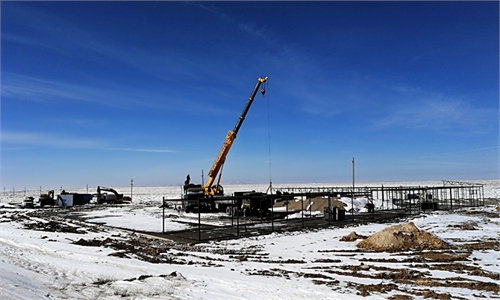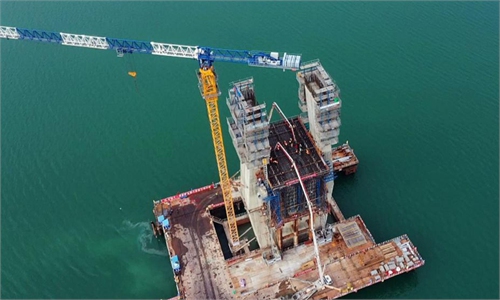
A ceremony was held in Yichang, Central China's Hubei Province to kick off construction of several projects on February 8, 2022. Investment in the projects reached 12.19 billion yuan ($1.91 billion). China is increasingly investment to tackle downward pressure. Photo: cnsphoto
Local governments across China are scrambling to build infrastructure projects after the 2022 Spring Festival holiday, with a focus on transportation and new infrastructure, as the country tries to stabilize economic growth with what experts said is the only effective tool it has, when both consumption and trade growth are facing uncertainties amid the lingering coronavirus crisis.
As of Wednesday, 12 provinces and municipalities in China had announced 16,079 key investment projects for 2022, with total investment of more than 25 trillion yuan ($3.95 trillion), according to the Securities Daily.
Infrastructure projects account for a large proportion of local governments' investment plans this year, with some regions planning to pour about 80 percent of their investment capital into infrastructure projects. For many areas, the proportion has increased from last year.
The new rush to beef up infrastructure is evident everywhere. For example, the operation rates of vehicle cranes and pump trucks reached 73.99 percent and 54.8 percent, respectively, in January, according to Central China Television (CCTV).
Transportation projects continue to be a focus of this year's infrastructure investment. East China's Jiangxi Province, for example, plans to invest 964.5 billion yuan in a total of 641 infrastructure projects this year, including transportation projects like the Ruichang airport, as well as reconstructing a section of the Shanghai-Kunming expressway.
Southwest China's Guizhou Province will kick off more than 400 major infrastructure projects with a total investment of 114 billion yuan. An integral part of the money is flowing into transportation, including airport projects in Weining and Panzhou, as well as railway and freeway projects.
Apart from transportation, new infrastructure projects are another highlight in this year's infrastructure investment, with many provinces preparing to deploy more 5G base stations. For example, South China's Guangdong Province has announced plans to build a new batch of key national laboratories, while speeding up 5G network to cover all county regions in eastern, western and northern Guangdong with 5G broadband.
A major force behind local governments' strengthened efforts to fuel infrastructure projects is the need to stimulate and stabilize economic growth, at a time when the other two major engines of economic growth -- consumption and trade -- are facing uncertainties amid the coronavirus crisis, experts said.
"Currently, infrastructure investment is almost the only major method open to local governments to realize more than 5 percent GDP growth," Lin Jiang, a professor of economics at Sun Yat-sen University, told the Global Times on Thursday.
According to Lin, the fact that China's central government allocated new local government debt quotas ahead of schedule demonstrated the government's inclination to shore up economic growth via infrastructure investment.
"When local governments receive the quotas, they formulate plans in January. Now, they're implementing the plans after the Spring Festival holiday," said Lin.
Earlier, the Ministry of Finance announced new local government debt quotas totaling 1.78 trillion yuan for 2022 ahead of schedule, according to information released by the China Government Debt Center.
Chen Chuanglian, deputy dean of the Southern China Institute of Finance, Jinan University, told the Global Times on Thursday that as China's economy shifts from an investment-driven model to one powered by consumption, infrastructure facilities like roadways and railways are still insufficient in some regions, and many cities' infrastructure construction lags behind the pace of urbanization.
"This year's infrastructure investment will still focus on major transportation projects, with the aim of speeding up China's urbanization," Chen said, predicting that the contribution of new infrastructure construction to China's GDP will increase by about 0.4-0.6 percentage points this year.
However, experts noted that China's infrastructure investment is facing some challenges, such as a lack of funding and the fact that infrastructure networks in many regions are basically complete.
Lin suggested that local governments designate infrastructure projects as auxiliary facilities to local manufacturing projects, as upgrading infrastructure could help stimulate the improvement of the manufacturing industry, and vice versa. More private capital should be channeled into such investment, Lin noted.




